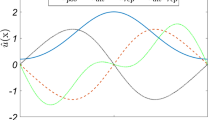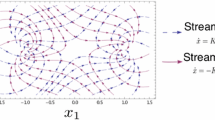Abstract
We develop a time-dependent perturbation theory for nonequilibrium interacting particle systems. We focus on models such as the contact process which evolve via destruction and autocatalytic creation of particles. At a critical value of the destruction rate there is a continuous phase transition between an active steady state and the vacuum state, which is absorbing. We present several methods for deriving series for the evolution starting from a single seed particle, including expansions for the ultimate survival probability in the super- and subcritical regions, expansions for the average number of particles in the subcritical region, and short-time expansions. Algorithms for computer generation of the various expansions are presented. Rather long series (24 terms or more) and precise estimates of critical parameters are presented.
Similar content being viewed by others
References
G. Nicolis and I. Prigogine,Self-Organization in Nonequilibrium Systems (Wiley-Interscience, New York, 1977).
H. Haken,Synergetics (Springer-Verlag, New York, 1983).
P. Grassberger and A. de la Torre,Ann. Phys. (NY)122:373 (1979).
P. Grassberger,J. Phys. A 22:3673 (1989).
R. M. Ziff, E. Gulari, and Y. Barshad,Phys. Rev. Lett. 56:2553 (1986).
I. Jensen, H. C. Fogedby, and R. Dickman,Phys. Rev. A 41:3411 (1990).
R. Dickman,Phys. Rev. B 40:7005 (1989).
R. Dickman,Phys. Rev. A 42:6985 (1990).
T. Aukrust, D. A. Browne, and I. Webman,Phys. Rev. A 41:5294 (1990).
I. Jensen,Phys. Rev. A 43:3187 (1991).
R. Dickman,Phys. Rev. A 34:4246 (1986).
R. Dickman,Phys. Rev. A 38:2588 (1988).
H. K. Janssen,Z. Phys. B 42:151 (1981).
H. K. Janssen,Z. Phys. B 58:311 (1985).
H. K. Janssen and B. Schmittmann,Z. Phys. B 64:503 (1986).
P. Grassberger,Z. Phys. B 47:365 (1982).
G. Grinstein, Z.-W. Lai, and D. A. Browne,Phys. Rev. A 40:4820 (1989).
R. C. Brower, M. A. Furman, and M. Moshe,Phys. Lett. B 76:213 (1978).
R. Dickman and M. Burschka,Phys. Lett. A 127:132 (1988).
R. Dickman,J. Stat. Phys. 55:997 (1989).
D. Poland,Physica A 173:363 (1991).
T. M. Liggett,Interacting Particle Systems (Springer-Verlag, New York, 1985); R. Durrett,Lecture Notes on Particle Systems and Percolation (Wadsworth, Pacific Grove, California, 1988).
T. E. Harris,Ann. Prob. 2:969 (1974).
F. Schlögl,Z. Phys. B 253:147 (1972).
J. L. Cardy and R. L. Sugar,J. Phys. A 13:L423 (1980).
R. J. Baxter and A. J. Guttmann,J. Phys. A 21:3193 (1988).
R. Dickman and I. Jensen,Phys. Rev. Lett. 67:2391 (1991).
C. Bezuidenhout and G. Grimmett,Ann. Prob. 18:1462 (1990).
I. Jensen,Phys. Rev. A 45:R563 (1992); I. Jensen,Phys. Rev. A 46:7393 (1992).
M. Doi,J. Phys. A 9:1465, 1479 (1976).
P. Grassberger and M. Scheunert,Fortschr. Phys. 28:547 (1980).
L. Peliti,J. Phys. (Paris)46:1469 (1985).
A. J. Guttmann, inPhase Transitions and Critical Phenomena, Vol. 13, C. Domb and J. Lebowitz, eds. (Academic Press, New York, 1989).
J. W. Essam, A. J. Guttmann, and K. De Bell,J. Phys. A 21:3815 (1988).
D. ben-Avraham, R. Bidaux, and L. S. Schulman,Phys. Rev. A 43:7093 (1991).
J. Adler, M. Moshe, and V. Privman, inPercolation Structures and Processes (Annals of the Israel Physical Society, Vol. 5), G. Deutsher, R. Zallen, and J. Adler, eds. (Hilger, Bristol, 1983).
R. Dickman, J.-S. Wang, and I. Jensen,J. Chem. Phys. 94:8252 (1991).
G. A. Baker, Jr.,Essentials of Padé Approximants (Academic Press, New York, 1975).
G. A. Baker, Jr.,Quantitative Theory of Critical Phenomena (Academic Press, New York, 1990), Chapters 13–18.
P. J. Flory,J. Am. Chem. Soc. 61:1518 (1939).
Y. Fan and J. K. Percus,Phys. Rev. Lett. 67:1677 (1991).
A. Baram and D. Kutasov,J. Phys. A 22:L251 (1989).
R. Dickman and T. Tomé,Phys. Rev. A 44:4833 (1991).
W. Kinzel and J. Yeomans,J. Phys. A 14:L163 (1981).
W. Kinzel,Z. Phys. B 58:229 (1985).
Author information
Authors and Affiliations
Rights and permissions
About this article
Cite this article
Jensen, I., Dickman, R. Time-dependent perturbation theory for nonequilibrium lattice models. J Stat Phys 71, 89–127 (1993). https://doi.org/10.1007/BF01048090
Received:
Revised:
Issue Date:
DOI: https://doi.org/10.1007/BF01048090




